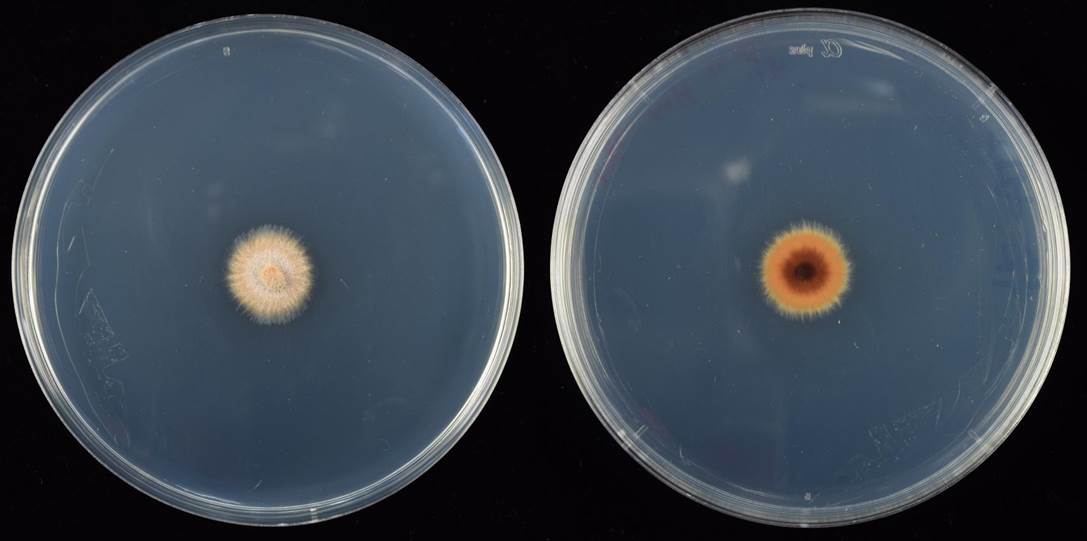Myrmecridium schulzeri
| Authors |
(Sacc.) Arzanlou, W. Gams & Crous 2007 |
| Strain |
12015 |
| Classification |
Myrmecridiales, Myrmecridiaceae, Myrmecridium |
| Culture collection |
BCRC FU30016 |
| Detection frequency |
Low |
| Accession number |
LC494379 |
| Figure |
 Fig. 1 5-day-old colony on PDA Fig. 1 5-day-old colony on PDA  Fig. 2 Myrmecridium schulzeri. a–b. Conidiophores and conidia. c. Sporulation on CM. d. Conidia. (Bars= 5 μm, unless otherwise specified) Fig. 2 Myrmecridium schulzeri. a–b. Conidiophores and conidia. c. Sporulation on CM. d. Conidia. (Bars= 5 μm, unless otherwise specified) |
| Colonies |
Colonies on PDA attaining 17-mm at 25 °C after 5 days, cottony, pale orange, turning orange and slimy with age, margins filiform, reverse dark orange, paler toward the margin. |
| Conidiophores |
Conidiophores macronematous, arising vertically from the creeping hyphae, with broader basal cell, straight or flexuous, mostly simple, occasionally with one or more branches, subhyaline to brown, subhyaline at the apex, darker towards the base, thick-walled, up to 200 µm long, 2–4 µm wide; basal cell 4–6 µm wide. |
| Conidiogenous cells |
Conidiogenous cells integrated, terminal or intercalary, denticulate. |
| Conidia |
Conidia subhyaline, obovoid or fusiform, 1-celled, with acuminate base, 5–9 µm long, 2–4 µm wide. |
| Note |
This species has been found in soils or saprophytic on grasses (CBS 304.73 from wheat straw; CBS 325.74 from Triticum aestivum root) and many different plant hosts (Arzanlou et al., 2007). This species is also a opportunistic pathogen to humans. Myrmecridium resembles Ramichloridium, the latter is also commonly found in nature. Myrmecridium can be distinguished from Ramichloridium by having hyaline vegetative hyphae and orange colonies on PDA. Further detail distinction between both genera can refer to Arzanlou et al. (2007). |
| Pathogenicity |
Unknown |
| Specimens examined |
Taiwan, Yunlin County, rice grains (cultivar Tainan 11), Sep 2012, Jie-Hao Ou, 12015 |
| ITS |
CCAGCGGAGGGATCATTACGAGAGTGTCACCACTCCCAACCCATTGTTTACCTACCCGTCCACCGTGCTTCGGCAGGCAGCCCTGTGGGACAGAGCCTCGCCCCCCTCCGCGGGGGGTGCCTGCCGCTGGCCAACCAACAACTCTAGCTGTTTTAGTACCATCTGAGTCTTCCACAAATGAACAAAACTTTCAACAACGGATCTCTTGGTTCTGGCATCGATGAAGAACGCAGCGAAATGCGATAAGTAATGTGAATTGCAGAATTCAGTGAATCATCGAATCTTTGAACGCACATTGCGCCCACTAGTATTCTGGTGGGCATGCCTGTTCGAGCGTCATTTCAACCCTCAAGCCTGGCTTGGTGTTGGGGCTCTGCGCAACGCAGTCCCTTAAATTCAGTGGCGGACACGCTAGGTCTCCGAGCGCAGTAGTTTCTTCTCGCTTCGGGCGTCCGGCGTGGGCTTGCCTCGCACCCAACTTCTCAAGGT |
 Fig. 1 5-day-old colony on PDA
Fig. 1 5-day-old colony on PDA  Fig. 2 Myrmecridium schulzeri. a–b. Conidiophores and conidia. c. Sporulation on CM. d. Conidia. (Bars= 5 μm, unless otherwise specified)
Fig. 2 Myrmecridium schulzeri. a–b. Conidiophores and conidia. c. Sporulation on CM. d. Conidia. (Bars= 5 μm, unless otherwise specified)